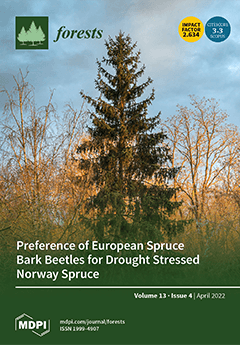Intensive forest afforestation with native pine species was developed in the 1960s on degraded and deforested lands in the region of the Eastern Rhodopes (south-eastern Bulgaria). Severe damage by wet snow was registered in the coniferous forests of the Rhodopes in March 2015. In the following years, bark beetle attacks were registered on the broken and felled fresh wood. As a result, bark beetle infestation spots appeared in the pine plantations. In the period 2019–2021, damage caused by bark beetles was assessed in the region of State Forestry Kirkovo (the Eastern Rhodopes, south-eastern Bulgaria). An integrated approach using the data of the information system of the Executive Forest Agency (ISEFA), remote sensing data obtained by an “eBee SQ” unmanned aerial vehicle (UAV) equipped with a “Parrot Sequoia” multispectral camera, and subsequent terrestrial observations, was applied. ISEFA data showed that there was no serious damage caused by abiotic and biotic factors in the pine forests of SF Kirkovo until 2014. Snow damage in 2015 affected 513 ha of pine plantations, and bark beetle infestations reached up to 1316 ha in 2016. In 2019, a total of 226.87 ha of pine plantations were captured in three localities—Fotinovo, Kirkovo, and Kremen. The relative share of damage caused by bark beetles was greater in
P. sylvestris plantations (15.3–23.0%), compared to damage in
P. nigra (2.3%). Four different categories of normalised difference vegetation index (NDVI) were separated in bark beetle infestation spots—living trees, dead trees, grass and shrub vegetation, stones and rocks. The NDVI values in locations with living trees varied between 0.500 (spaces between tree crowns) and 0.700 (central part of the crown projection) (an average of 0.617). In the locations with dead trees, the average values of NDVI of lying trees was 0.273, and in standing trees, NDVI varied between 0.275 (central part of crown projections) and 0.424 (spaces between tree crowns). In the locations with grass and shrub vegetation, stones and rocks, the average NDVI was 0.436 and 0.329, respectively. In the field study, average defoliation of 31.2–32.3% was registered in
P. sylvestris plantations, and 47.4% in
P. nigra plantations. Defoliations mainly were caused by pine processionary moth (
Thaumetopoea pityocampa) and fungal pathogens (
Dothistroma septosporum and
Lecanosticta acicola). The damage was caused by
Ips acuminatus (in
P. sylvestris only), and
I. sexdentatus,
Tomicus piniperda and
T. minor (in
P. sylvestris and
P. nigra). Infestations by other xylophages, such as
Phaenops cyanea,
Rhagium inquisitor, and
Pissodes spp., were also found on pine stems.
Full article





